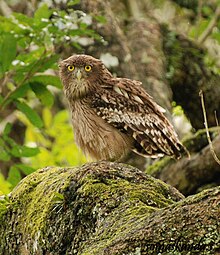Brown fish owl
| Brown fish owl | |
|---|---|
 |
|
| Biligiriranga Hills (BR-Hills), Karnataka | |
| Scientific classification | |
| Kingdom: | Animalia |
| Phylum: | Chordata |
| Class: | Aves |
| Order: | Strigiformes |
| Family: | Strigidae |
| Genus: | Bubo (but see text) |
| Species: | B. zeylonensis |
| Binomial name | |
|
Bubo zeylonensis (Gmelin, 1788) |
|
| Diversity | |
| 3–4 living subspecies, and see text | |
| Synonyms | |
and see text |
|
and see text
The brown fish owl (Bubo zeylonensis or Ketupa zeylonensis) is a species of owl that is part of the family known as typical owls, Strigidae, which contains most living owls. It inhabits the warm subtropical and humid tropical parts of continental Asia and some offshore islands. Of the four living species of fish owl, it is the most widely distributed, most common and best-studied. It occupies a range of over 7,000 km (4,300 mi) from eastern China to Palestine.
The four fish owls were previously generally separated in the genus Ketupa. mtDNA sequence data is equivocal on which genus name is applied for them, and today they are commonly lumped with the horned and eagle-owls (Bubo) – which they also resemble osteologically very much – for sake of convenience. Depending on whether some little-studied tropical eagle-owls are closer to the fish-owls than to the typical eagle-owls, Ketupa might be a valid genus if these as well as the fishing owls (formerly Scotopelia) are included in it, although there are a number of osteological differences that suggest that fishing and fish owls are not directly related to each other.
This species is an all-year resident throughout most tropical and subtropical parts of the Indian Subcontinent to Southeast Asia and adjoining regions. West of its main range, it is patchily distributed to the Levant (possibly extinct) and southern Asia Minor (recently rediscovered). The typical habitat of brown fish owls is forest and woodland bordering streams, lakes or rice fields. It inhabits mainly the lowlands, from open woodland to dense forest as well as in plantations; in the Himalayas foothills it ranges into submontane forest up to 1,500 m (4,900 ft) ASL or so but not higher. It frequently spends the day in stands of bamboo or other large shady trees. They be found around water reservoirs (or jheels in India), along canals, on the outskirts of villages and along sea coasts. Western birds are found in semiarid landscape and may breed in oases in arid regions. Regardless of habitat, it rarely strays far from larger bodies of water such as rivers and lakes.
...
Wikipedia

